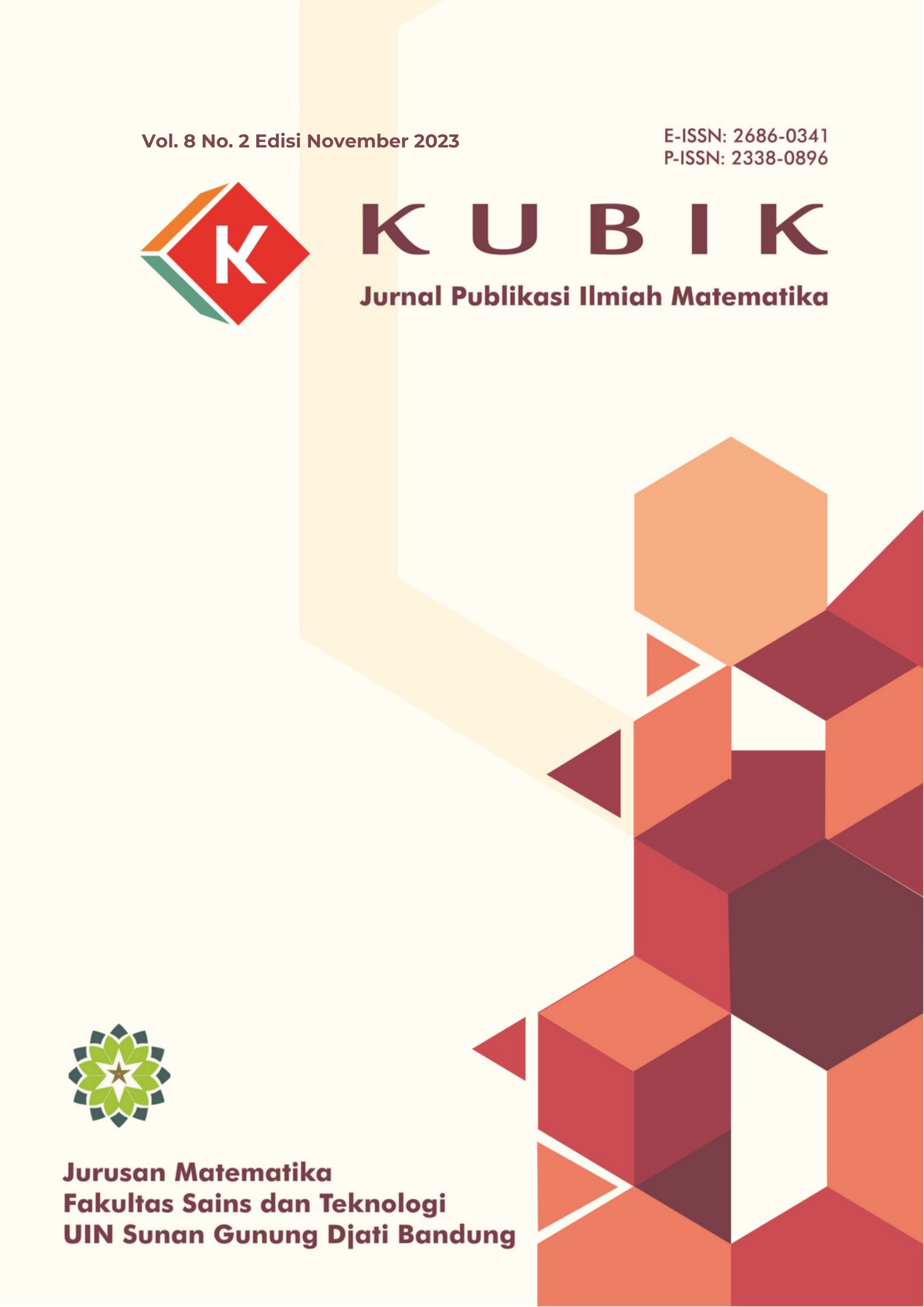Penerapan Perangkat Lunak RStudio untuk Penaksiran Parameter Model Spatial Autoregressive
DOI:
https://doi.org/10.15575/kubik.v8i1.30037Keywords:
RStudio, Spatial Autoregressive (SAR), Spatial Weight MatrixAbstract
Research and analysis that are not only based on time (temporal) but also on space (spatial) require tools in the form of software to ensure that the data analysis and processing yield good, fast, and accurate results. One of the software tools that can be used for this purpose is RStudio software. The advantages of RStudio include being open-source software (OSS), which can be used freely without cost, and it has many packages and functions that can facilitate data processing. One of the spatial-based analyses is spatial data analysis. The structure within RStudio allows users to call functions related to spatial data analysis, perform computations with sparse matrices (matrices with many zero values), such as spatial weight matrices, estimation of spatial model parameters, and so on. This research examines the application of RStudio software in estimating the parameters of a first-order Spatial Autoregressive (SAR) model using the Maximum Likelihood Estimation (MLE) method on the data of the designation of Intangible Cultural Heritage (ICH) in Indonesia. Based on the results of applying RStudio software, a first-order SAR model with a Queen contiguity weight matrix for the categories of Traditional Customs, Rituals, and Celebrations (TCRC) and Performing Arts (PA) with the minimum Akaike Information Criterion (AIC) value and maximum pseudo-Â value was obtained for predicting the designation data of ICH in Indonesia. The application of RStudio software to the first-order SAR model for the designation data of ICH in Indonesia speeds up and simplifies calculations, making it suitable as a recommendation for relevant agencies such as the Department of Culture, Tourism, Youth, and Sports (Disbudparpora).
ÂReferences
Sarvina, Y. (2017). ‘Pemanfaatan Software Open Source “R†untuk Penelitian Agroklimat’. Informatika Pertanian, 26(1), pp. 23–30. doi:https://doi.org/10.35580/variansiunm24
Ruchjana, B. N., Khoirunnisa, H., & Suhandi, B. (2020). Perbandingan Penerapan Metode Agglomerative dengan Metode K-Means pada Data Curah Hujan di Wilayah Bogor. KUBIK: Jurnal Publikasi Ilmiah Matematika, 5(2), 71-82.
Mahading, T. S., Resmawan, Yahya, L., & Akolo, I. R. (2020). Metode Spatial Autoregressive dalam Analisis Kerawanan Demam Berdarah Dengue di Kota Gorontalo. JMPM: Jurnal Matematika Dan Pendidikan Matematika, 5(2), 9–19.
Aulia, I., Chamid, M. S., & Andari, S. (2017). ‘Pemodelan Pneumonia pada Balita di Surabaya Menggunakan Spatial Autoregressive Models’. Jurnal Sains Dan Seni ITS, 6(1), pp. 89–93. doi:10.12962/j23373520.v6i1.22437
Ramadeni. (2020). ‘Model Spatial Autoregressive (SAR) pada Tingkat Kemiskinan (Studi Kasus : Provinsi Riau)’. Jurnal Sains Matematika Dan Statistika, 6(2), pp. 61–72. doi:http://dx.doi.org/10.24014/jsms.v6i2.10530
Walpole, R. E., Myers, R. H., Myers, S. L., & Ye, K. (1993). Probability and Statistic for Engineers and Svientists (D. Lynch, Ed.; 9th ed.). Boston: Pearson.
Anselin, L. (1988). Spatial Econometrics: Methods and Models (Vol. 4). Santa Barbara: Springer Netherlands.
Sobari, M., Desiyanti, A., Yanti, D., Monika, P., Abdullah, A. S., & Ruchjana, B. N. (2023). Comparison of Spatial Weight Matrices in Spatial Autoregressive Model: Case Study of Intangible Cultural Heritage in Indonesia. JTAM (Jurnal Teori Dan Aplikasi Matematika), 7(1), 244–261.
Yasin, H., & Saputra, R. (2013). Pemetaan Penyakit Demam Berdarah Dengue dengan Analisis Pola Spasial di Kabupaten Pekalongan. Media Statistika, 6(1), 27–36.
Falah, A. N., Ruchjana, B. N., Abdullah, A. S., & Rejito, J. (2023). The Hybrid Modeling of Spatial Autoregressive Exogenous Using Casetti’s Model Approach for the Prediction of Rainfall. Mathematics, 11(17), 3783.
Pratama, A. D., Suparta, I. W., & Ciptawaty, U. (2021). Spatial Autoregressive Model and Spatial Patterns of Poverty in Lampung Province. Eko-Regional: Jurnal Pembangunan Ekonomi Wilayah, 16(1).
Lee, J., & Wong, D. W. S. (2001). Statistical Analysis with ArcView GIS. 1st ed. Canada: John Wiley.
Lutfi, A., Aidid, M. K., & Sudarmin. (2019). ‘Identifikasi Autokorelasi Spasial Angka Partisipasi Sekolah di Provinsi Sulawesi Selatan Menggunakan Indeks Moran’. VARIANSI: Journal of Statistics and Its Application on Teaching and Research , 1(2), pp. 1–8.
Ruchjana, B. N., Arianto, A. T., Parmikanti, K., & Suhandi, B. (2021). Peramalan Konsentrasi Particulate Matter 2.5 (PM2. 5) menggunakan Model Vector Autoregressive dengan Metode Maximum Likelihood Estimation. KUBIK: Jurnal Publikasi Ilmiah Matematika, 6(1), 1-12.
Lesage, J. P. (1999). The Theory and Practice of Spatial Econometrics. Tersedia di: http://www.econ.utoledo.edu (Diakses: 12 September 2022).
Acquah, H. D. (2013). ‘On the Comparison of Akaike Information Criterion and Consistent Akaike Information Criterion in Selection of an Asymmetric Price Relationship: Bootstrap Simulation Results’. AGRIS On-Line Papers in Economics and Informatics, 5(1), pp. 3–9.
Mendez, C. (2020). Spatial Regression Analysis in R. Tersedia di: https://rpubs.com/quarcs-lab/tutorial-spatial-regression (Diakses: 20 Juni 2023).
Fitriani, R., & Efendi, A. (2019). Ekonometrika Spasial Terapan dengan R. Malang: Tim UB Press.
Downloads
Published
How to Cite
Issue
Section
Citation Check
License
Authors who publish in KUBIK: Jurnal Publikasi Ilmiah Matematika agree to the following terms:
- Authors retain copyright and grant the journal right of first publication with the work simultaneously licensed under a Attribution-ShareAlike 4.0 International (CC BY-SA 4.0) License that allows others to share the work with an acknowledgment of the work's authorship and initial publication in this journal.
- Authors are able to enter into separate, additional contractual arrangements for the non-exclusive distribution of the journal's published version of the work (e.g., post it to an institutional repository or publish it in a book), with an acknowledgment of its initial publication in this journal.
- Authors are permitted and encouraged to post their work online (e.g., in institutional repositories or on their website) prior to and during the submission process, as it can lead to productive exchanges, as well as earlier and greater citation of published work (See The Effect of Open Access).
Â









